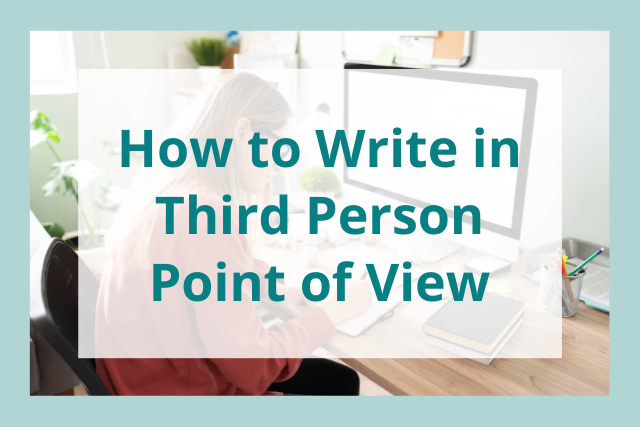
Whether you’re going to write a short story, a novella, or a novel, one of the most important decisions you’ll need to make is which point of view (POV) to use.
Third person is the most popular POV for fiction writers to use. It gives the reader a chance to experience the narrative from a perspective above, or on the shoulder of, the characters.
In this article, we’ll learn what the third person POV is, how it compares to other points of view, and how to write in third person point of view.
What Is Third Person Point of View?
Third person POV is when the narrator exists outside of the story. This narrator relates the actions of the characters by using their name or third person pronouns such as “she,” “he,” and “they.”
There are three types of third person POV that you can choose from. Each POV provides a different reader experience as they reveal different amounts of information about the narrative, characters, and setting.
To decide on a POV, think about the type of story you are telling and whether your readers need to be aware of certain details at each point in the plot.
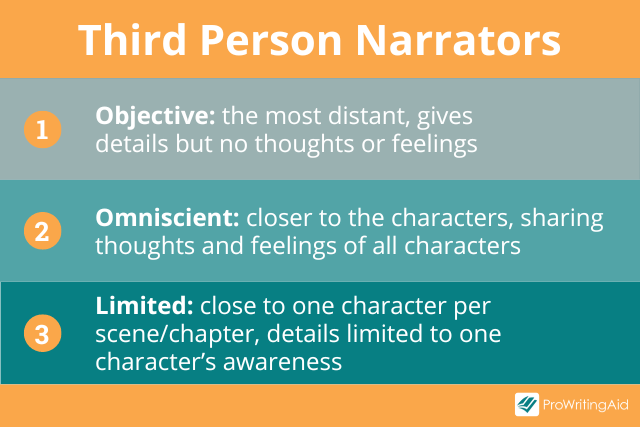
1. Third Person Objective Point of View
The third person objective POV is a way to tell your story by giving the reader all the details within the scenes without including what is going on in the characters’ minds.
To write in the third person objective POV, you will need to create an unbiased narrator who doesn’t tell the reader the thoughts and feelings of the characters. Instead, your narrator will simply relay the actions and dialogue of the story in an objective, impartial telling of the events.
This is great for keeping distance between the reader and the characters. It’s like looking through the window of a stranger’s house and trying to figure out why everything is happening.
2. Third Person Omniscient Point of View
When writing in the third person omniscient POV, you give your reader an all-access pass to the thoughts and feelings of any character in each scene of your story. You can give as much detail about the scene as you can in the third person objective POV, but this time you can also include information from the characters’ perspectives.
The narrator you create to speak in the third person omniscient POV will need to relay the thoughts and feelings of all the relevant characters in the scene. You can do this by switching perspectives. This is sometimes called “head hopping.”
You can use head hopping to show conflict in the story. For example, one paragraph is from the main character’s perspective, as they give some important information to another character. Then, the next paragraph is from the perspective of the person who received the information, which shows their reaction to what the main character just said.
Third person omniscient is perfect for sharing all the little details about the world you have created and allows the reader to pick up clues that some characters might not have noticed. Some writers refer to the third person omniscient POV as an all-seeing being who likes to give their thoughts on the plot.
3. Third Person Limited Point of View
This narrator sits on the shoulder of your main character and tells the story from their perspective. It’s close to being first person, but the reader isn’t solely within the character’s mind and this narrator still uses third person pronouns and verbs.
Sometimes, the third person limited POV narrator sticks to a different character each chapter instead of one character throughout the entire story. We refer to this as a viewpoint character, as we are seeing the world from their perspective.
You are controlling the amount of information given to the reader by focusing on one character’s awareness, rather than all characters’.
First Person vs Third Person
First person POV gives readers full access to the thoughts and feelings of the main character, as they are the one telling the story. There isn’t a narrator getting between the reader and the character.
Another key part of writing in the first person POV is that the character uses first person pronouns to tell the story. They use “I,” “me,” “my,” and “myself” as they are talking about actions and experiences.
Remember: not all main characters notice everything going on around them. It can break the reader’s immersion if they are wondering how the main character knew they were about to die, but there were no clues it was about to happen. Not all characters are psychic!
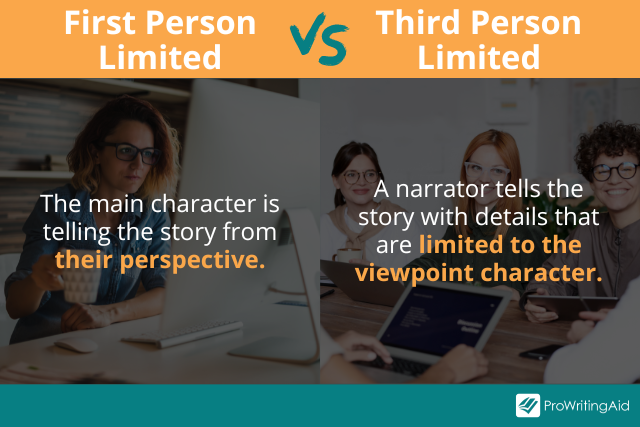
If you’re aiming to stick to one character’s thoughts and feelings, but you also want to add in some extra details that are in the character’s peripheral vision, try the third person limited perspective.
This POV can be used to great effect in thrillers where you want to stay close to the main character, so the reader connects with them.
Meanwhile, you can also give clues about things that are about to happen that the character is unaware of. Let us watch in horror as the character falls down a hole we all saw coming, but could do nothing to stop them.
Second Person vs Third Person
Second person POV puts you, the reader, in the driving seat as the main character. The narrator breaks the fourth wall and speaks to you directly.
This perspective uses second person pronouns such as “you,” “your,” and “yourself” to bring the reader into the narrative. The narrator uses third person pronouns to refer to other characters.
Second person works well in stories where you want full immersion for the reader. Some people love the feeling of being dropped onto the rollercoaster of drama in a good story. This is why second person is used in video games and Choose Your Own Adventure stories.
However, it is one of the least used POV types by fiction writers. One reason for this is that it takes a lot of skill to write about the reader in a way that feels natural to them while also giving away the right amount of information for the story. You don’t want your reader to lose interest because they don’t agree with something the narrator has said.
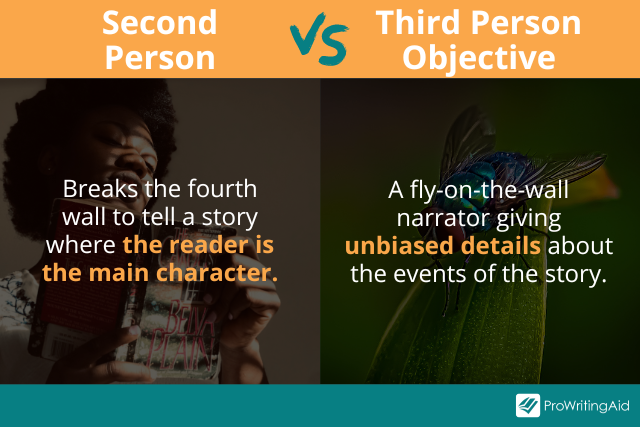
Third person objective would be a better option if you don’t want to write as though your story is about the person reading it. The third person POV allows the reader to focus more on the narrative and everything else that’s going on around the characters.
Third Person POV Meaning
So far, we’ve discussed what the third person POV is, but what does the “third person” part of that mean?
Third person is a grammatical style of writing that uses pronouns such as “she,” “he,” “they,” and “it.” It also uses proper nouns and names when referring to specific individuals and objects.
How to Write in Third Person
1. Decide If Third Person Provides the Right Reader Experience
Do you want to tell the story from within the mind of your main character? Do you want to make the reader the main character of the story? If the answer is no to both questions, it’s time to look at your options for writing in the third person.
2. Pick the Type of Third Person Narrator
Go over the details of your story and your characters. You will need to establish whether third person limited, third person objective, or third person omniscient is the best POV for your story.
3. Read Examples of Writing in Third Person
It’s important to take the time to analyze what works and what doesn’t work in third person narration. The best way to do this is by reading other works that use third person points of view.
Focus on the information they are sharing. Did it work? Would you have used a different type of narrator for that story?
4. Use a Consistent POV
Switching POVs is a habit that a lot of writers do if they’re writing in a POV they’re not used to. Don’t worry, it happens. However, being aware that this is something to avoid before you get 200 pages into your novel and realize you switched POVs back on page 90 can help you be more observant of your writing habits.
5. Use the Correct Pronouns—ProWritingAid Can Help!
The third person POV means using third person pronouns when your narrator is speaking. Remembering this is one of the best ways to catch yourself from slipping into different points of view.
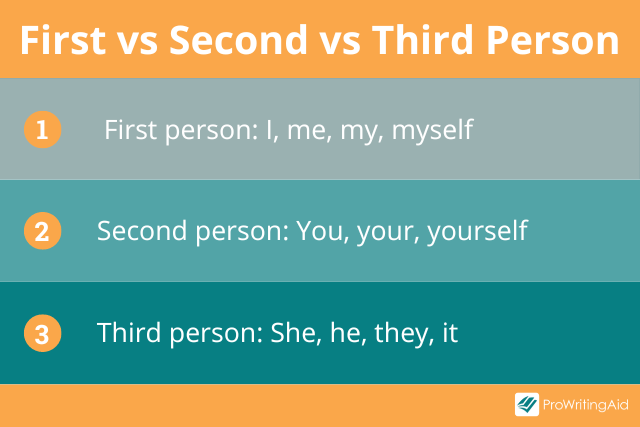
You can stop yourself from using the wrong pronouns by using ProWritingAid’s pronoun report. It’ll highlight all the examples of pronouns in your text, so you can easily work through your story and change them back into the third person if you’ve made any mistakes.
6. Create a Trustworthy Third Person Narrator
Your third person narrator is the voice of your narrative. How do they tell the story? Do we believe them?
Readers need to feel like your narrator has the authority to tell these events in a way that satisfies them. If you want to share the thoughts and feelings of the characters, the narrator needs to sound like they are confident in the details they are sharing.
Third Person POV Examples
Third Person Objective Example
If you’re wondering how to show conflict when writing in the third person objective POV, we would recommend reading Hills Like White Elephants by Ernest Hemingway.
Let’s look at an excerpt from the story:
The woman brought two glasses of beer and two felt pads. She put the felt pads and the beer glasses on the table and looked at the man and the girl. The girl was looking off at the line of hills. They were white in the sun and the country was brown and dry.
“They look like white elephants,” she said.
“I’ve never seen one.” The man drank his beer.
“No, you wouldn’t have.”
“I might have,” the man said. “Just because you say I wouldn’t have doesn’t prove anything.”
The girl looked at the bead curtain. “They’ve painted something on it,” she said. “What does it say?”
“Anis del Toro. It’s a drink.”
As you can see from this extract, the third person objective narrator is relaying the information about the scene without being biased to either of the characters. They do not quote the characters’ thoughts or feelings; they simply give details about their actions and words.
As a reader, you can still imagine what the characters are thinking and feeling, as the conflict is laid out bare for you to witness.
Third Person Omniscient Example
Readers of the third person omniscient POV expect the narrator to be all-seeing and all-knowing, so it makes sense that the narrator in Good Omens by Neil Gaiman and Terry Pratchett is “God” or the “Almighty.”
Here’s an extract from the novel:
“Er. Okay,” he said. “I’ll, er, be off then. Shall I? Get it over with. Not that I want to get it over with,” he added hurriedly, aware of the things that could happen if Hastur turned in an unfavourable report. “But you know me. Keen. So I’ll be popping along,” Cowley babbled. “See you guys... see you. Er. Great. Fine. Ciao.”
As the Bentley skipped off into the darkness Ligur said, “Wossat mean?”
“It’s Italian,” said Hastur. “I think it means food.”
“Funny thing to say, then.”
Ligur stared at the retreating tail-lights. “You trust him?” he said.
“No,” said Hastur.
“Right,” said Ligur. It’d be a funny old world, he reflected, if demons went round trusting one another.
This example shows how the third person omniscient narrator pops into the heads of several characters in one passage. At the beginning, we’re in Cowley’s mind, which is shown by the phrase “aware of things that could happen if Hastur turned in an unfavourable report.” However, within a few lines, we pop into Ligur’s mind, which is apparent in the sentence, “It’d be a funny old world, he reflected, if demons went round trusting one another.”
Third Person Limited Example
If you’re looking for examples of third person limited narrators that tell the story from one character’s perspective, we would recommend reading Happily Ever After by Harriet Evans.
Let’s check out a section of the novel:
She knew his face so well, knew him so well, how he drummed his fingers on any spare surface, how he looked vague when trying to get out of things, how his mouth curled to the side when he was making a joke. But she’d never sat this close to him before, because he was her boss. It didn’t feel like that tonight. It was as if they were different people. It was nice. Rory was nice, but then, she’d always known that.
Romance writers like writing first person POV, but third person limited also works well in this genre, like in this extract. The narrator is giving us a direct connection to the mind of the main character (Elle). They do this by describing everything Elle’s noticed about the man she’s attracted to.
Elle realizes her boss has always been nice and we get the impression she’s always secretly wanted to date him. The narrator shows us this by giving us Elle’s perspective on what’s happening in the scene. It’s as close as the narrator can be without Elle telling the story herself.
Conclusion on How to Write in Third Person POV
As you can see, writing in the third person isn’t hard when you follow the step-by-step process. It’s a lot of fun to experiment with the different types of third person POV. Which one do you prefer?
Don’t forget, if you’re worried about slipping into different POVs within your writing, you can always use the ProWritingAid pronoun report to keep you in check!

